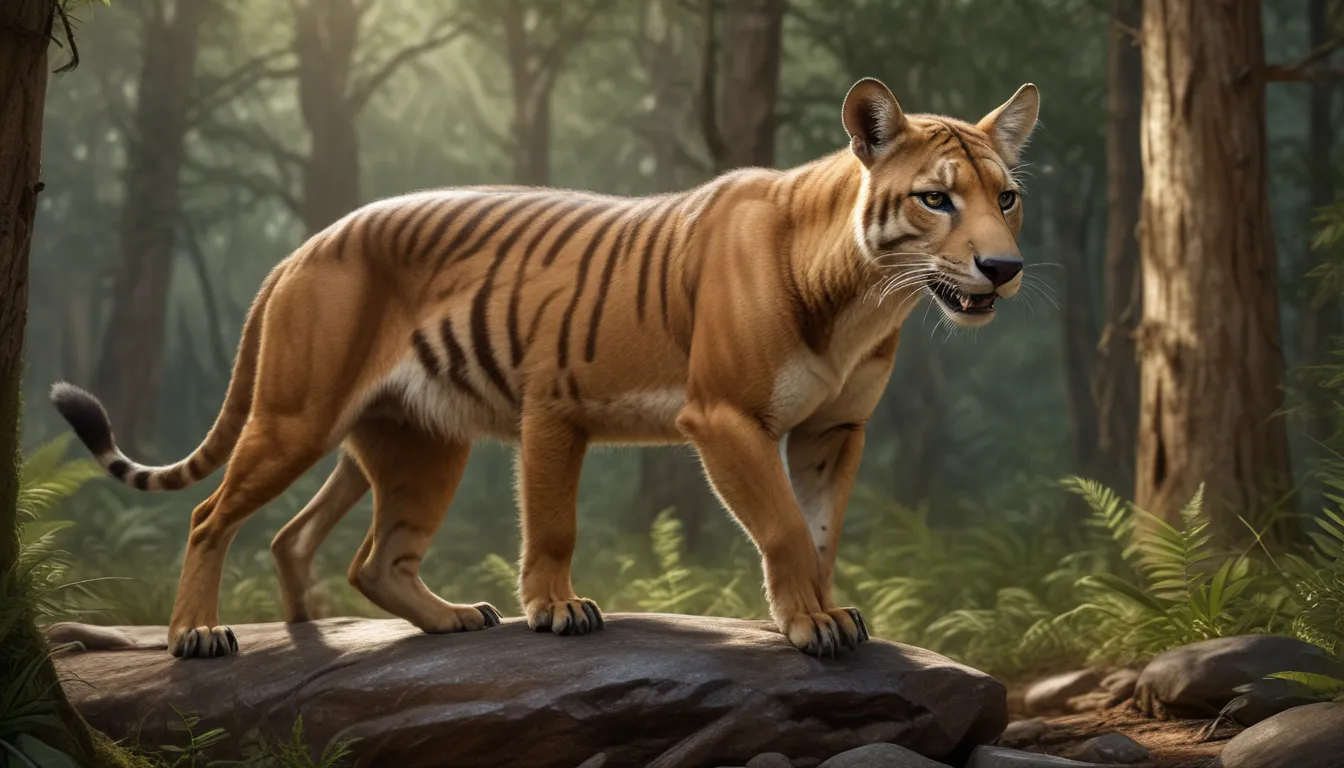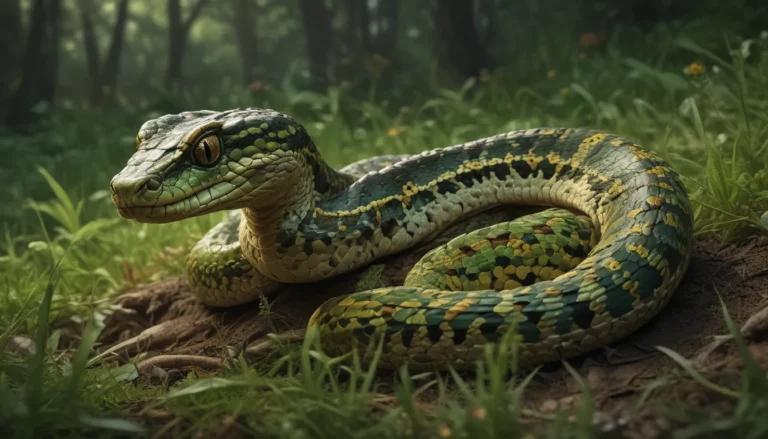The pictures we use in our articles might not show exactly what the words say. We choose these pictures to make you interested in reading more. The pictures work together with the words but don’t take their place. The words still tell you the important facts.
Travel back in time to the rugged wilds of Tasmania, Australia, and New Guinea, where a unique and enigmatic creature once roamed – the Tasmanian Tiger, also known as the Thylacine. Despite its name, this marsupial bore no relation to tigers but shared a captivating presence in the annals of Australia's natural history. Join us on a journey of discovery as we unravel 18 intriguing facts about the Tasmanian Tiger, shedding light on its physical attributes, behavior, and unfortunate demise. Let's embark on an adventure filled with wonder and insight into the world of this remarkable creature.
Unveiling the Tasmanian Tiger: A Unique Marsupial
The Tasmanian Tiger, or Thylacine, was a carnivorous marsupial that inhabited the rugged landscapes of Tasmania, Australia, and New Guinea. Resembling a large dog with distinctive tiger-like stripes on its back, this solitary creature left an indelible mark on the ecosystem. Despite its extinction, the legacy of the Tasmanian Tiger serves as a poignant reminder of the impact of human activities on wildlife and the delicate balance of nature. Let us delve deeper into the world of this enigmatic marsupial and uncover the mysteries that shroud its existence.
Unraveling the Physical Characteristics of the Tasmanian Tiger
1. Unique Pouch Design
While most marsupials possess a front-opening pouch, the Tasmanian Tiger's pouch faced towards its tail, showcasing a remarkable adaptation. This flexible pouch could stretch to accommodate multiple joeys, reflecting the species' reproductive strategy and nurturing behavior.
2. Kangaroo-Like Tail
Sporting a stiff and muscular tail akin to that of a kangaroo, the Tasmanian Tiger utilized this feature for balance and stability while on the move. With powerful hind legs and a robust tail, these marsupials demonstrated agility and grace in their hunting pursuits.
3. Solitary Nature
Known for their solitary lifestyle, Tasmanian Tigers preferred solitude, coming together solely during the breeding season. This behavior, while preserving their independence, posed challenges for successful mating and contributed to their population decline.
4. Remarkable Jaw Structure
The Tasmanian Tiger boasted a jaw that could open up to an impressive 120 degrees, enabling it to capture and consume larger prey with ease. This unique adaptation exemplified the species' prowess as a skilled hunter in the Tasmanian wilderness.
5. Nocturnal Predator
Operating under the cover of darkness, Tasmanian Tigers were primarily active at night, utilizing their excellent night vision to hunt small to medium-sized animals such as kangaroos, wallabies, and birds. Their nocturnal habits provided them with a strategic advantage in the darkened landscape.
6. Distinctive Vocalizations
With a vocal repertoire of short, sharp barks or yelps, the Tasmanian Tiger emitted a distinctive yapping call that echoed through the Tasmanian wilderness. This unique vocalization served as a form of communication and territory marking, adding to the species' mystique.
7. Extinction Triggers
The plight of the Tasmanian Tiger's extinction can be attributed to a myriad of human-induced factors, including widespread hunting, habitat loss, and the introduction of invasive species like dogs and foxes. Considered a threat to livestock, these marsupials faced persecution that hastened their demise.
8. Controversial Reputation
Often perceived as a nuisance by farmers, Tasmanian Tigers were targets of government-sanctioned extermination campaigns aimed at protecting livestock. Despite historical animosity, recent years have witnessed a resurgence of interest in conserving and potentially rediscovering this enigmatic species in the wild.
Peril and Persistence: The Legacy of the Tasmanian Tiger
9. Extinction Narratives
The Tasmanian Tiger's complex extinction saga unfolds through a tapestry of factors, including habitat destruction, competition with introduced predators, and disease outbreaks. Yet, reports of sightings in remote regions have fueled speculation about the species' potential survival in isolated pockets.
10. Unique Parenting Traits
Female Tasmanian Tigers possessed a cloaca, a single opening serving both reproductive and waste elimination functions. This evolutionary adaptation enabled them to give birth to live young and carry their offspring in the pouch until they were sufficiently developed to venture out into the world.
11. Diverse Dietary Preferences
While primarily carnivorous, Tasmanian Tigers displayed a versatile palate, consuming fruits, birds' eggs, and small reptiles alongside their meat-based diet. This adaptability to varying food sources underscored their resilience in diverse habitats.
12. Identifiable Stripes
Similar to human fingerprints, the distinct pattern and arrangement of stripes on the back of each Tasmanian Tiger provided a unique identifier for researchers and wildlife enthusiasts. These individual markings facilitated research and conservation efforts aimed at understanding the species.
13. Cloning Controversies
Advancements in cloning and genetic engineering have sparked debates about the potential revival of the Tasmanian Tiger using preserved DNA samples. While the scientific feasibility of resurrection remains uncertain, ethical considerations and practical implications continue to shape discussions on species conservation.
Immortalizing a Legend: Cultural Significance and Scientific Inquiry
14. Cultural Reverence
Embedded within the traditions and narratives of the Tasmanian Aboriginal people, the Tasmanian Tiger holds profound cultural significance. Its presence in stories, art, and rituals reflects a deep connection to the indigenous heritage of Tasmania, honoring the species' legacy through cultural expressions.
15. Scientific Intrigue
Despite its extinction, the Tasmanian Tiger remains a subject of scientific curiosity, inspiring researchers to delve into its remains, genetics, and ecological impact. Through ongoing studies, scientists seek to unravel the mysteries of this unique marsupial and glean valuable insights for conservation and biodiversity preservation.
Conclusion: Preserving the Legacy of the Tasmanian Tiger
The saga of the Tasmanian Tiger, with its blend of mystery and tragedy, beckons us to reflect on the intricate tapestry of nature's wonders and vulnerabilities. As we contemplate the 18 fascinating facts that illuminate the life and times of this remarkable marsupial, we are reminded of the fragility of our planet's biodiversity and the imperative of conservation efforts.
While the Tasmanian Tiger may no longer prowl the Tasmanian wilderness, its legacy endures in the hearts and minds of those captivated by its enigmatic presence. By embracing the rich history and profound lessons embedded within the narrative of the Tasmanian Tiger, we empower ourselves to advocate for endangered species and safeguard the intricate web of life that sustains our planet.
Explore Further: Quolls, Conservation, and Cryptids
As we bid adieu to the Tasmanian Tiger, our journey of exploration continues into the realm of captivating Australian wildlife. Delve into the world of quolls, another iconic species with a rich heritage and conservation significance. Embark on an odyssey through astonishing facts about wildlife conservation and its pivotal role in shaping our planet's future. For those drawn to the allure of mysterious creatures, venture into the realm of the chupacabra, a cryptid that has tantalized imaginations for generations.
FAQs: Your Curiosity Answered
Q: What is a Tasmanian Tiger?
A: The Tasmanian Tiger, or Thylacine, was a carnivorous marsupial native to Tasmania, Australia, and New Guinea.
Q: Did the Tasmanian Tiger have any predators?
A: As an apex predator in its habitat, the Tasmanian Tiger did not have natural predators within its ecosystem.
Q: Can the Tasmanian Tiger species be reintroduced?
A: Due to the extinction of the species, reintroduction is currently not viable.
Q: How can I contribute to Tasmanian Tiger conservation?
A: Support organizations and research initiatives dedicated to the study and preservation of endangered species, including the Tasmanian Tiger.
Q: Why is the Tasmanian Tiger important?
A: The Tasmanian Tiger symbolizes the fragility of wildlife in the face of human activities and serves as a poignant reminder of the need for conservation efforts.
Q: Are there any living Tasmanian Tigers today?
A: There are no known living Tasmanian Tigers, with the last individual perishing in captivity in 1936.
Q: What was the diet of the Tasmanian Tiger?
A: Tasmanian Tigers predominantly fed on small to medium-sized animals such as kangaroos, wallabies, and birds, in addition to fruits and small reptiles.
Q: Can the Tasmanian Tiger be cloned?
A: While discussions about cloning the Tasmanian Tiger have arisen, successful cloning attempts have not been realized to date.
Embrace the allure of the Tasmanian Tiger's legacy, and immerse yourself in a world brimming with tales of wonder and conservation triumphs. As we unravel the mysteries of this enigmatic marsupial, let us cherish the lessons it imparts on the delicate dance of life and the vital role we play in preserving the biodiversity of our planet. Join us on a journey of discovery and enlightenment as we honor the timeless legacy of the Tasmanian Tiger and champion the cause of wildlife conservation for generations to come.






